Jun 29 2017
Thursday – Failing to break through
Wednesday
It’s a busy week. Lots of things going on at work, including customers visiting and a business dinner on Tuesday evening. On top of that, temperatures are reaching > 30 degrees, already for more than a week, and on Tuesday it was 35 degrees with extreme humidity. At home, the thermostat in the living shows 28 degrees, and in the bedrooms it is warmer. This severely impacts my sleep quality.
On Wednesday morning, I rode to work. It was a dusty, high ozone affair, but I was glad I did it, knowing that the repair of my single hadn’t started, there was strong wind predicted due to cooler air nearing our region, and the fact that I still hadn’t found time to prepare my quarterly Town Hall meeting.
The mailman delivered “How bad do you want it? Mastering the psychology of mind over muscle”. I read just the foreword, because I had a presentation to prepare.
[amazon_link asins=’B017OE42OE’ template=’ProductAd’ store=’rowingdata-20′ marketplace=’US’ link_id=’6cae1162-5cc1-11e7-a87d-db440d6dab67′]
Thursday
With the Masters Nationals in two weeks, I wanted to know where I stand. I got up early to get the workout in before work, and the plan was to do a trial 1k. I had originally planned to do this one on Friday, but it seemed smart to do it today. When I arrived at the lake, I was greeted by very choppy water. While the coolness has still not arrived (it was 21C at 5am), this is already the second day with strong wind.
I decided to row to the castle and row the 1k on the “straight kilometer”. The wind isn’t weaker on this stretch, but because the river is a lot narrower than the lake, the chop is reduced.
Usually I try to row these trials in calm weather, but this time I thought it doesn’t matter. I have a power meter, right? I am just measuring my max power over a certain duration. So, I thought, I might as well row the 1k in the headwind. Who knows when I will have to row a race in headwind, so I might just as well try to find out how hard I can pull over, what, 4 minutes and a bit? Just 1k. How hard can it be?
Before the row, I looked up my CP chart:
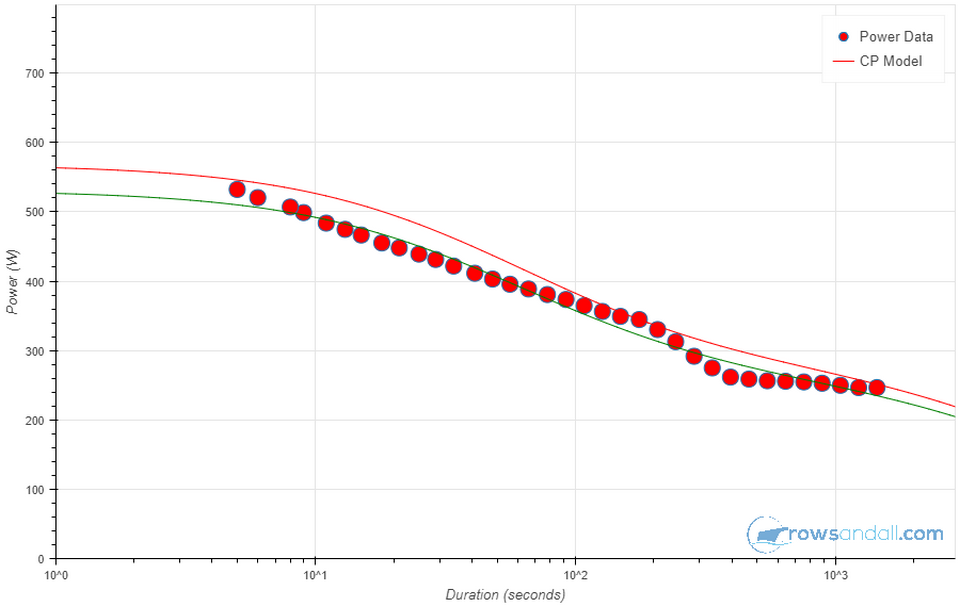
For a competitive person, there is a problem with this chart: It looks like a challenge. I want to move the data points to the right, or up. And as a bonus, if you set up notifications on rowsandall.com, you get a congratulatory email for every time you break through the red line.
For a four minute effort, the green line is at 305W, while the red line is at 326W. So, the plan was to do a start, then drop back to 320W, then try to increase in the final 250m, all the while monitoring technique. I was already composing the blog post with a before and after CP chart. I was also looking forward to rowing this 1000m “smart”, and not fly and die.
The reality was different. I had forgotten how hard 1k rows are, especially in the morning, alone, in non-ideal conditions.
I crossed the lake in heavy chop, then into the gorge. I did a few 10 stroke bursts on the straight kilometer, and a few practice starts after I turned around at the castle. I had the impression that the wind was getting stronger. I lined up for the start, dialed up a 1k, took a deep breath, and got started.
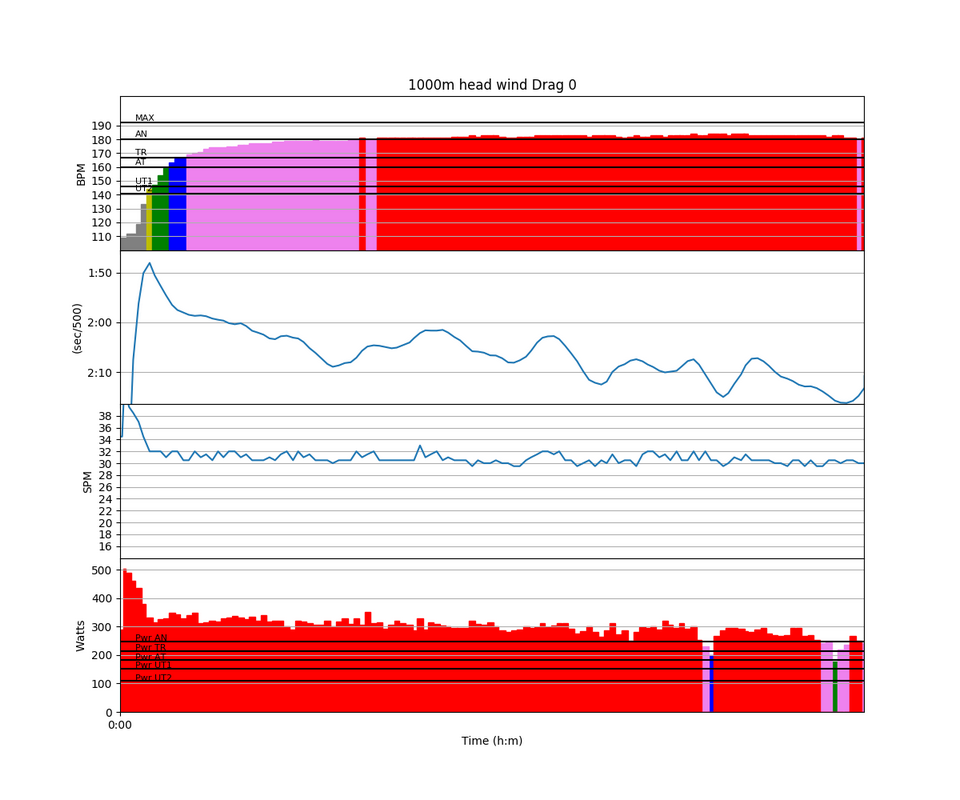
The plan fell apart after 200m. I didn’t know it immediately, though. I came out of the start strokes with 400W, and then I lowered the power by lowering the stroke rate, which probably was a mistake. I should have lightened up the stroke but not allow the stroke rate to drop below 32spm. It is very hard to recover from a low stroke rate. At that moment, I wasn’t aware of these risks. I just saw that there were strokes where the power was getting close to 300W. I tried to get the power back to decent values but it was very hard. Drifting a bit to port, I also had to turn slightly, which doesn’t help with the recorded power on the starboard oarlock. The gusty wind didn’t help either.
Anyway, here are the splits:
Workout Summary - media/20170629-063736-Sanders SpeedCoach 20170629 0653amo.csv
--|Total|-Total-|--Avg--|-Avg-|Avg-|-Avg-|-Max-|-Avg
--|Dist-|-Time--|-Pace--|-Pwr-|SPM-|-HR--|-HR--|-DPS
--|01000|04:13.0|02:04.4|304.8|31.1|176.1|184.0|07.7
W-|01000|04:13.0|02:04.6|303.8|31.1|176.8|184.0|07.7
R-|00000|00:00.0|00:00.0|000.0|00.0|000.0|184.0|00.0
Workout Details
#-|SDist|-Split-|-SPace-|-Pwr-|SPM-|AvgHR|MaxHR|DPS-
00|00100|00:24.4|02:01.4|384.0|34.5|135.9|167.0|07.7
01|00100|00:24.0|02:00.7|328.6|31.2|173.9|177.0|08.0
02|00100|00:25.2|02:05.9|313.7|30.9|178.6|180.0|07.7
03|00100|00:25.1|02:04.5|315.8|30.8|180.4|181.0|07.7
04|00100|00:24.3|02:02.6|303.7|30.9|181.5|183.0|08.5
05|00100|00:25.2|02:05.8|298.4|30.6|182.4|183.0|07.3
06|00100|00:26.0|02:09.8|287.2|30.4|182.6|183.0|07.6
07|00100|00:26.3|02:11.3|283.7|31.1|182.9|184.0|07.4
08|00100|00:26.3|02:08.4|282.6|30.3|183.4|184.0|07.6
09|00100|00:26.8|02:14.0|249.9|30.1|182.1|183.0|08.1
Interesting enough, the average split was very close to what I had estimated before. I was expecting 2:05, based on the wind strength. So even though the power was lower than expected, the pace was in the ballpark.
I had about 3km to cool down and think about my failure. In the headwind, and demotivated, I didn’t go very fast. The lake part, the final 2km, were virtually unrowable. I saw plots around 3:30 per 500m. I eventually made it back to the club.
Of course, I want to set a better record. I even contemplated doing this again tomorrow. I probably won’t do it, but going into the last two weeks before the Nationals, I will have to focus on 1k race preparation, and do at least two more trials.
Anyway, today’s failure should lead to tomorrow’s success, and at least it will motivate me to read in the book about sport and psychology.
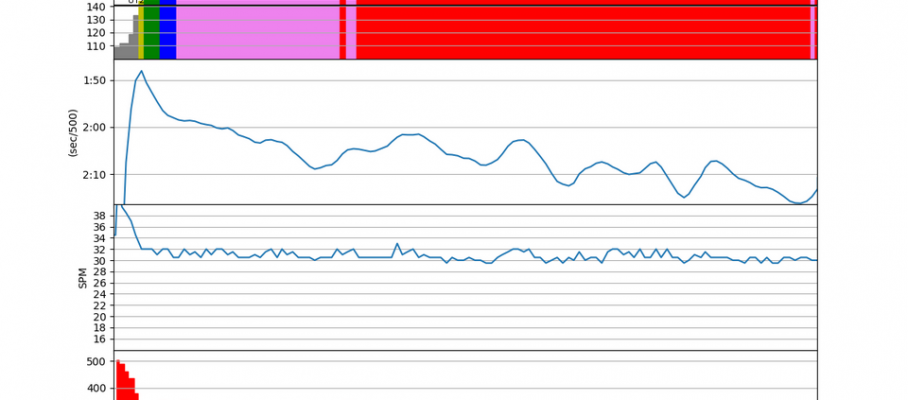
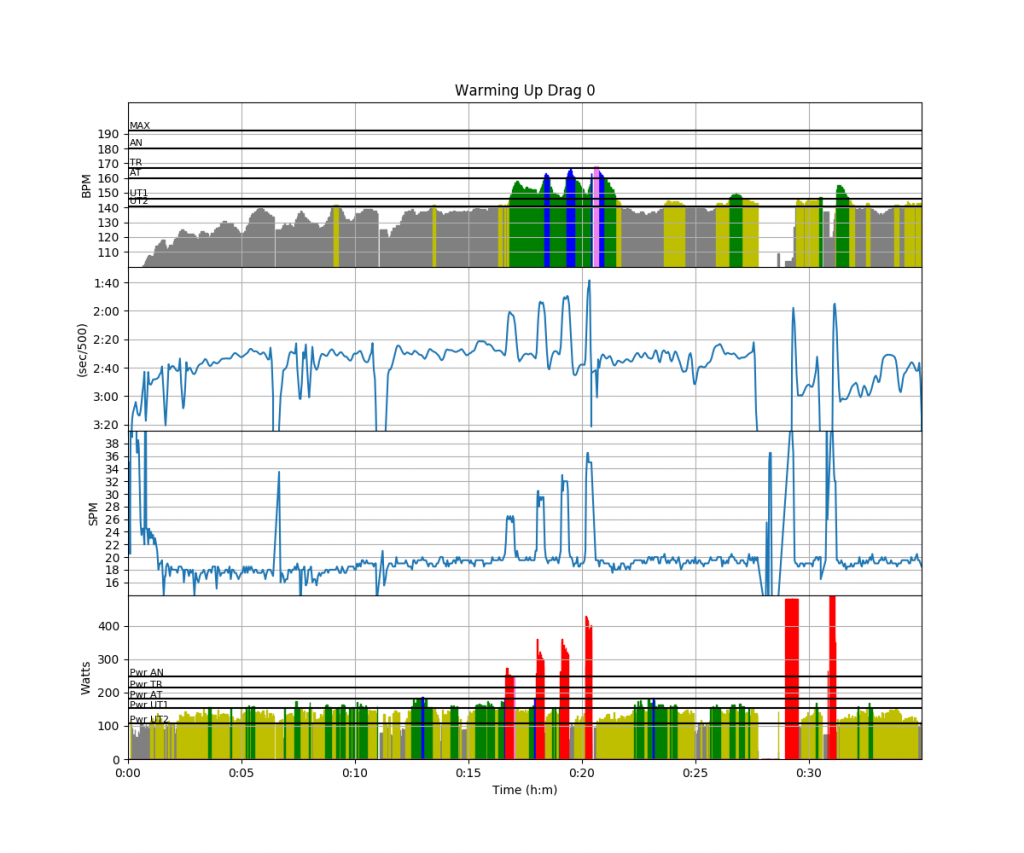
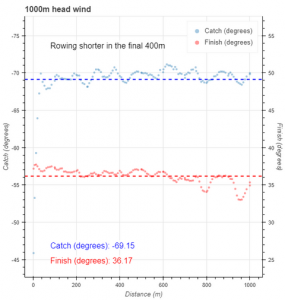
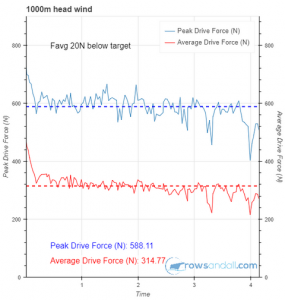
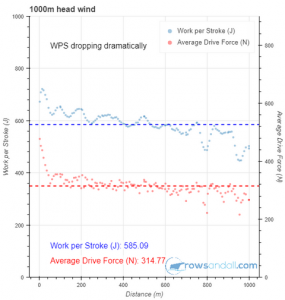
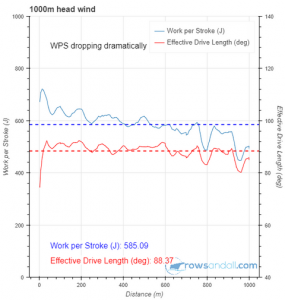
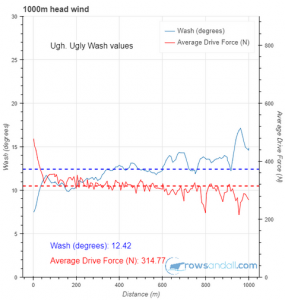
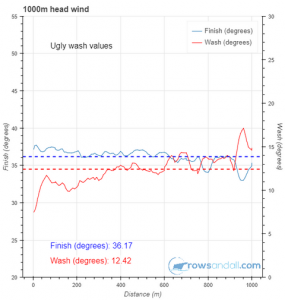
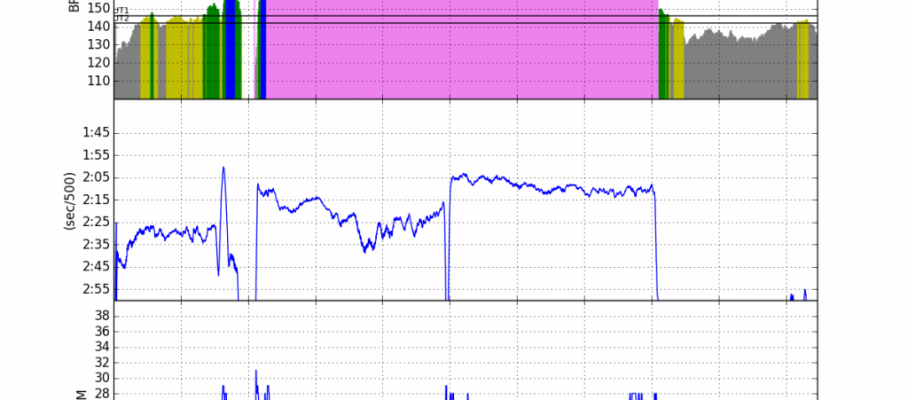
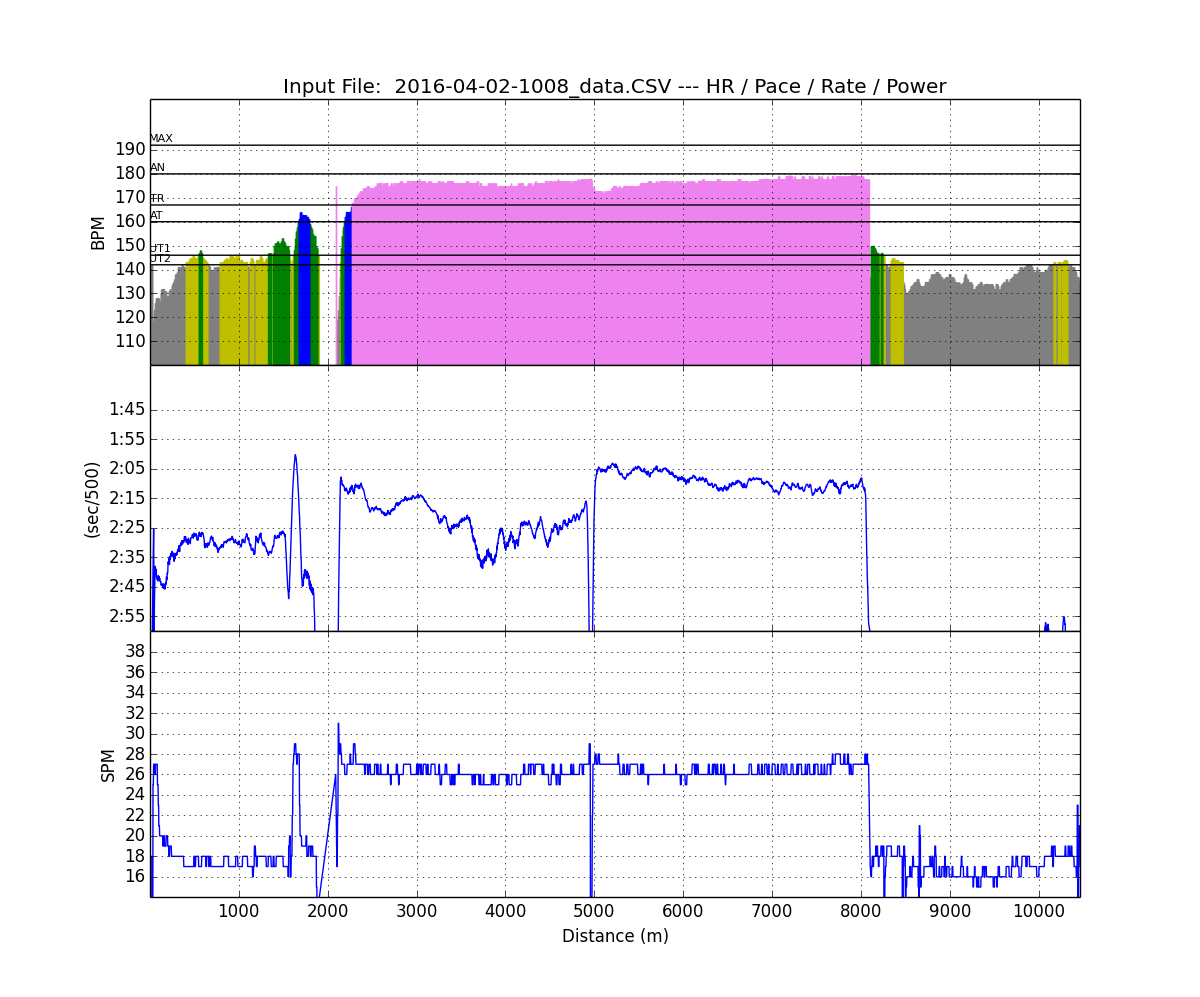
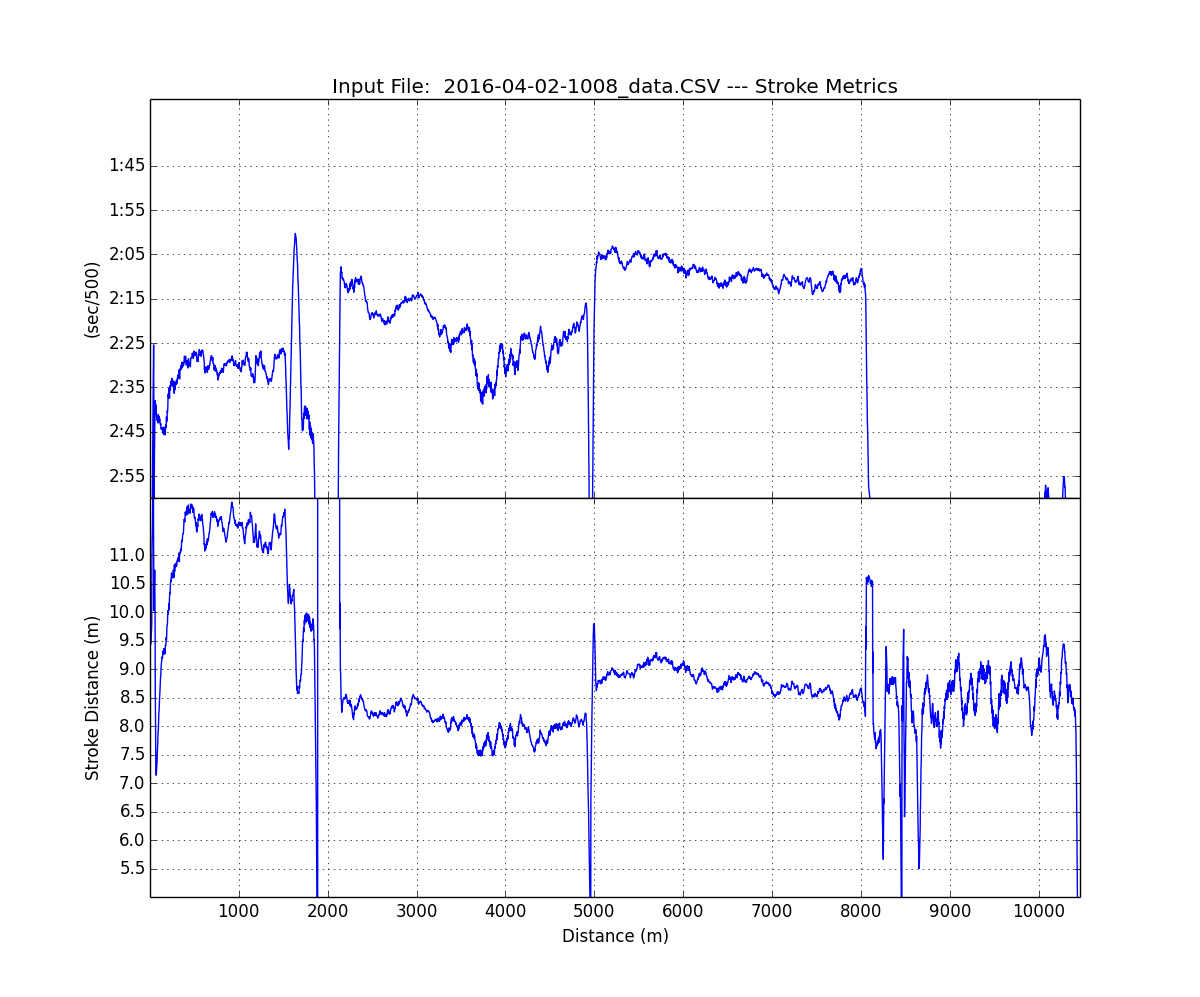
Mar 18 2018
Sunday – All worked out well
All worked out well.
I planned a “hard 6k” for Saturday, anticipating that I would be able to do it on the water, in the single. So, although it was supposed to be a hard 6k, I never intended it to be a full out one, this being my first or second OTW row of 2018.
It all worked out differently. It snowed on Saturday, and I decided to do the Steady State workout on my erg in my basement, and move the 6k to Sunday, when a small group of our Masters rowers meet at the rowing club and erg together.
I put the erg on slides, to get a bit closer to the OTW feeling, and, admittedly, also because erging a 6k is so much easier on slides. Did I mention that I am considering buying slides for use at home? I found a local guy who can make them really cost effective.
So here is the entire workout
I did a nice long warming up with some speed bumps. It’s easier to rate up on slides, so I found myself doing 40spm for a few strokes. Then, while the rest of the Masters started their 4x8min/2min workout (at 22/24/26/22spm), I started my 6k. The plan was to stick to 1:54 pace for the first 2400m and be careful, but I did see a lot of 1:52 pace, and when I got enthusiastic, even some 1:52 and 1:51.
With the other rowers next to me, I didn’t have difficult rating up in the second half of the row. It’s amazing how much peer pressure helps, although I also think that for a lightweight as me, rowing on slides is a definite advantage.
Workout Summary - media/20180318-1530530o.csv
--|Total|-Total-|--Avg--|-Avg-|Avg-|-Avg-|-Max-|-Avg
--|Dist-|-Time--|-Pace--|-Pwr-|SPM-|-HR--|-HR--|-DPS
--|06000|22:16.0|01:51.4|253.1|28.7|0.0|000.0|09.4
W-|06000|22:17.0|01:51.5|253.1|28.7|000.0|000.0|09.4
R-|00000|00:00.0|00:00.0|000.0|00.0|000.0|000.0|00.0
Workout Details
#-|SDist|-Split-|-SPace-|-Pwr-|SPM-|AvgHR|MaxHR|DPS-
00|00500|01:53.1|01:53.1|237.5|27.1|000.0|0.0|09.8
01|00500|01:53.6|01:53.6|239.5|26.6|000.0|0.0|09.9
02|00500|01:52.9|01:52.9|241.7|27.3|000.0|0.0|09.7
03|00500|01:53.5|01:53.5|240.9|27.0|000.0|0.0|09.8
04|00500|01:52.7|01:52.7|243.0|27.4|000.0|0.0|09.7
05|00500|01:52.2|01:52.2|247.1|27.9|000.0|0.0|09.6
06|00500|01:52.5|01:52.5|245.5|27.7|000.0|0.0|09.6
07|00500|01:52.5|01:52.5|247.4|28.3|000.0|0.0|09.4
08|00500|01:51.4|01:51.4|252.6|29.0|000.0|0.0|09.3
09|00500|01:49.5|01:49.5|265.1|29.8|000.0|0.0|09.2
10|00500|01:48.4|01:48.4|274.2|31.1|000.0|0.0|08.9
11|00500|01:45.5|01:45.5|307.8|35.2|000.0|0.0|08.1
Not a bad workout. Actually a Season’s Best, and pretty close to my PB (of 2 years ago) of 22:13.1.
Here are a few of the flex charts that I found interesting:
This slideshow requires JavaScript.
How-To
Rowing in our rowing club’s erg room is always a challenge, data wise. The ergs have PM3 monitors, and no heart rate adapter. To get Painsled to register anything, I need to use the iPhone connection kit plus a lightning to 30 pin adapter to get my iPhone to work with the monitor.
[amazon_link asins=’B074KG6G5Q’ template=’ProductCarousel’ store=’rowingdata-20′ marketplace=’US’ link_id=’77f1393f-2ad8-11e8-814d-abd3cf302b13′]
I do record heart rate separately, using the Polar OH1 optical heart rate belt worn on my upper arm. This heart rate band has a standalong mode, which syncs to Polar Flow, and then to Strava. Then, I can import the heart rate data using the Strava connection to rowsandall.com.
Before I merge the heart rate data with the rowing data, I first glue warming up, 6k and cooling down together on rowsandall.com, as described here.
Then, I go to the Advanced Edit page for the workout and select “Sensor Fusion”: Clicking the highlighted link brings me to a page where I select the heart rate data imported from Strava, and then I get to this page:
Clicking the highlighted link brings me to a page where I select the heart rate data imported from Strava, and then I get to this page:
I select heart rate, and as I started the heart rate band at the same time as I started rowing, I don’t need to edit the time offset.
If I wanted, I could now split the resulting workout again to get a nice record for my 6k with heart rate, but I didn’t have a need for that.
The sensor fusion, joining and splitting are experimental functions on rowsandall.com, and you have to try which approach gives you the best result. I find that when the workout durations are very different, like today where the OH1 recorded one hour long record, but the painsled workouts where divided in three parts, it is more efficient to first glue together the rows, and do the data fusion with workouts of approximately the same length. That creates a nice workout record for the entire session, which can then be split up again if you want.
For the stroke metrics plots, I used the original Painsled 6k workout, without heart rate data, and just browsed through my defined set of favorite flex charts, zooming in on stroke length and work per stroke using the flex tools. Pretty happy with what I saw.
By sanderroosendaal • Uncategorized • 0 • Tags: 6k, concept2, erg, OTE, rowing, test, training, trial